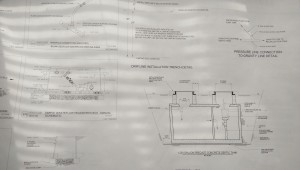Septic System Design
 Septic system design is a critical aspect of any development project not located within the jurisdiction of a sanitary sewer district. There are very strict requirements that must be satisfied in order to gain approval to install a new septic system. The design requirements to permit and install a septic system may vary significantly from county to county. It is extremely important to conduct a septic soil site evaluation or if necessary a percolation test and a groundwater monitoring study as soon as possible. A septic system study and preliminary design must be completed to know if the project site is even suitable to install a septic system, where a septic system must be installed and what type of septic system needs to be installed. Factors that determine if you can install a septic system and which type of septic system can be installed are the soil condition, groundwater depth and distance to sensitive features such as well, pools, ponds, stormwater drainage channels, streams, steep hillsides and property lines.
Septic system design is a critical aspect of any development project not located within the jurisdiction of a sanitary sewer district. There are very strict requirements that must be satisfied in order to gain approval to install a new septic system. The design requirements to permit and install a septic system may vary significantly from county to county. It is extremely important to conduct a septic soil site evaluation or if necessary a percolation test and a groundwater monitoring study as soon as possible. A septic system study and preliminary design must be completed to know if the project site is even suitable to install a septic system, where a septic system must be installed and what type of septic system needs to be installed. Factors that determine if you can install a septic system and which type of septic system can be installed are the soil condition, groundwater depth and distance to sensitive features such as well, pools, ponds, stormwater drainage channels, streams, steep hillsides and property lines.
Traditional or standard septic systems consist of a septic tank and a leach field. These standard type septic systems usually allow wastewater to gravity flow from the building to the septic tank where solids settle out of the wastewater and are contained in the septic tank. A septic tank should be cleaned out by a professional septic tank service about every 5-years to remove solids. Wastewater drains from the septic tank into the septic leach field. The septic leach field is the most important part of the septic system. Standard septic systems usually allow wastewater to gravity drain from the septic tank into the septic leach field. The septic leach field for a standard septic system usually consists of a trench filled with clean crushed rock and a perforated pipe placed above the rock. Wastewater flows from the septic tank to the septic leach field trench into the perforated pipe. Wastewater slowly drains out of the perforated pipe into the rock and into the surrounding soils. Current codes are very restrictive and there is only a very small chance that a property would have adequate soil type, adequate soil depth and enough room on the property to install a standard type septic system.
In the most likely case that a standard septic system cannot be installed on a property then an engineered septic system can most likely be installed. There are some cases where a new septic system cannot be installed and a property would be considered undevelopable. In some cases certain procedures may be taken to insure that a septic system can be installed on a property a few years in the future.
An engineered septic system consists of a septic tank, a pretreatment system and a pressurized septic leach field. An engineered septic system will usually allow wastewater to gravity flow into the septic tank were solids are settled out and contained. Wastewater will gravity flow or be pumped out of the septic system into a pretreatment system. A pretreatment system usually contains one or two additional underground tanks similar to a septic tank. A pretreatment system also usually contains pumps and a filter system of some kind. Wastewater is usually pumped from the pretreatment system into a pressurized septic leach field. The pressurized septic leach field for an engineered septic system usually consist of pressurized pipe with small perforations that disperse wastewater into a gravel bed or into a drip line network that does not require a gravel bed. Engineered septic systems are much more expensive to design and install than a standard type septic system.

